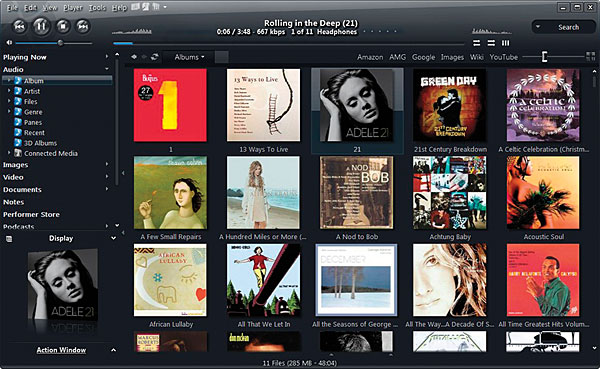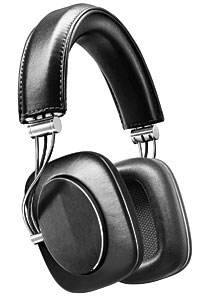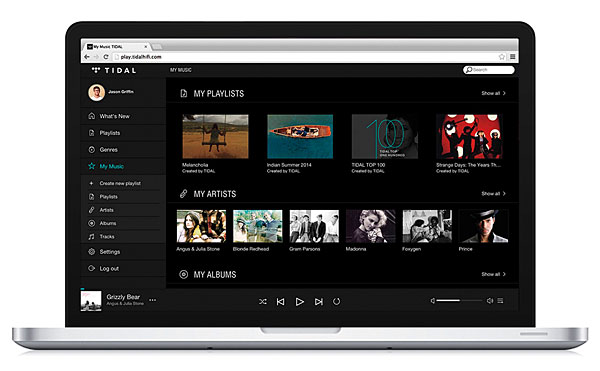I'm pretty old school. Extensive LP and CD library. I have a couple of CD's ripped from HD Tracks downloads and yes, they sound fantastic. My issue is storage. If I acquire a vast catalog of downloaded music in a high resolution format aren't I also needing a great deal of hard drive storage space? Granted it will take up less space than a CD or LP collection but aren't we still talking many many terabytes of data?
Guide To Hi-Res Audio - Step by Step


Hi-Res Audio, Step by Step: Your simple path to hi-res audio.
The benefits of Hi-Res Audio (HRA) are easy to see when you check the specs on paper. The CD format samples audio files at a 44.1-kilohertz rate (44,100 times a second) with 16-bit encoding. By comparison, hi-res systems sample the original analog signal at a much higher frequency than CD—most often either 96 or 192 kHz—and typically with 24-bit encoding. DSD, another hi-res format that is used for downloads from a few online services (and is still found on SACDs), uses only a 1-bit sample size but collects samples at either 2.8 or 5.6 megahertz—that is, 2.8 or 5.6 million times per second.
But getting involved in hi-res listening and being able to appreciate the sonic benefits of these differences, for now, probably requires some adjustments in how you collect and play your digital music. Here’s the simple, step-by-step plan for breaking into Hi-Res Audio.
Step 1: Download Some Hi-Res Library Software
The bulk of available hi-res music today comes from a range of online music stores and must be downloaded to your computer. That means you’ll have to install some appropriate library and player software. While iTunes can play HRA files, it has some limitations in its playback of hi-res music. Fortunately, you’ll find a number of hi-res media players available that run alongside or on top of iTunes and still let you use the standard iTunes library interface you’re used to. Popular software options in this category include Audirvana+ ($49), Amarra Hifi ($35), Pure Music 2 ($129) and BitPerfect ($10).

In addition, there are standalone media player applications with their own library and playlist interface that can handle HRA files. Popular options for the Windows platform include JRiver MediaCenter ($50), Foobar2000 (free), MediaMonkey (free) and Signalyst ($147)—JRiver and Signalyst are also available on the OS X side for Mac users. Most of these programs allow you to play DSD files in addition to those encoded as lossless FLAC files and straight PCM-format ones.
Step 2: Get a Quality DAC
Once you’ve got things straightened out on the software player side, it’s time to check out HRA-capable hardware. If you’re not using a hi-res portable or disc player with its own high-quality digital-to-analog converter (DAC) as your source, then a standalone USB DAC may be something you’ll want to look into. There are plenty of options here to consider, ranging from highly affordable ($100 and under) to pricey (thousands of dollars) and offering a range of features. Many provide an internal headphone amplifier for private listening along with the ability to connect your source computer to an external audio system. Some also include an integrated power amplifier, typically with sufficient power to drive desktop or bookshelf speakers.
No matter which USB DAC you choose, a key feature you’ll want to consider is an asynchronous transfer mode. This allows the DAC to bypass the computer’s internal timing and take control of the clock rate at which data is converted to audio—an important factor for eliminating timing errors that degrade sound quality.
You can find more about USB DACs in the HRA Gear Guide.
 Step 3: Make Everything Else Hi-Res
Step 3: Make Everything Else Hi-Res
Investing money in new media player software and a USB DAC doesn’t make sense if the rest of the gear you’ll use for HRA listening isn’t up to speed. The benefits you get with good hi-res recordings include wide dynamics (the distinction between softest and loudest sounds), crisp detail and a sense of spaciousness and depth that you just don’t get when listening to compressed streams or badly mastered CDs. But you’ll need to use speakers, amps and headphones of high enough quality to hear those benefits; the desktop speakers that came with your computer or inexpensive earbuds are not conducive to a true hi-res experience.
Fortunately, in a home theater environment, the same type of gear you depend on to deliver a good movie or music experience should also suffice for HRA—and you won’t need to upgrade your speakers or receiver. Just make sure the system has a good subwoofer for you to enjoy the extended bass you get with the best hi-res files, as well as amps powerful enough to let your speakers play loud passages with ease.
 For strictly desktop listening, you’ll definitely benefit by investing in a high-quality desktop speaker system. Headphones are also a good match for HRA audio listening; the intimate listening environment created through ’phones lends itself to picking up the added nuance of hi-res files. High-quality options from traditional headphone makers, along with newcomers and speaker manufacturers looking to get in on the game, have exploded in recent years. And with a good pair of headphones in your arsenal, you may also want to consider an HRA-capable portable player for listening to hi-res tunes on the move.
For strictly desktop listening, you’ll definitely benefit by investing in a high-quality desktop speaker system. Headphones are also a good match for HRA audio listening; the intimate listening environment created through ’phones lends itself to picking up the added nuance of hi-res files. High-quality options from traditional headphone makers, along with newcomers and speaker manufacturers looking to get in on the game, have exploded in recent years. And with a good pair of headphones in your arsenal, you may also want to consider an HRA-capable portable player for listening to hi-res tunes on the move.
Step 4: Play Time
The next step on your hi-res journey is probably the most fun: start collecting some music. The number of online stores that sell hi-res music is still somewhat limited compared with sites that offer compressed music for download, as is the overall range of content offered. Still, the online catalog is growing rapidly these days, with plenty of selections across a wide range of music genres.
The best known of HRA music download sites is probably HDtracks. This destination boasts an extensive collection of classical, jazz, rock and world music in 24-bit FLAC, ALAC, WAV and AIFF formats, much of it available in 88-, 96-, 176- and 192-kHz sample rates. Miles Davis, Black Sabbath, Richard Wagner, Led Zeppelin, even contemporary pop like Lady Gaga—it’s all there in hi-res. Another go-to site for HRA downloads is Acoustic Sounds’ Super HiRez store. While the selection here isn’t yet as extensive as what you’ll find at HDtracks, the site boasts plenty of titles available in the DSD format that some audiophiles prefer, including plenty of great classics such as Dave Brubeck’s Time Out, Steely Dan’s Gaucho, Michael Jackson’s Thriller and many others. And keep an eye out as well for the promised launch of hi-res streaming from the Tidal music service, which at this writing offers lossless CD-quality digital streaming (along with competitor Deezer). The company plans to bring its extensive music catalog to the streaming realm via Meridian’s MQA (Master Quality Authenticated) technology, a new compression scheme that allows heavy-bandwidth hi-res files to be shrunk down for Web streaming while still retaining their perceived quality at the receiving end. You can discover more hi-res music sites in “Where To Find Hi-Res Music”.

Flying High
Now that you’ve got your HRA software, hardware and music library in order, it’s time to sit back and luxuriate in all that hi-res goodness. Careful listeners will find much to appreciate in the meticulously mastered titles that are characteristic of the best HRA downloads, as compared with traditional CD. And Hi-Res Audio offers an enormous technical advantage over regular highly compressed downloads from the likes of iTunes and Amazon. If you truly care about sound quality and engaging with your music, you owe it to yourself to check it out.
- Log in or register to post comments


Yes, but that is cheap. I have two 3TB drives (one is physical backup). They're under $150 these days.

Yes hard drives are selling at bargain basement prices these days. The issue for me is I would need an entire forest of them to equal several thousand CD's worth of downloads. These files are BIG!

...and availability, for that matter.
If you're going to have nothing but disk-hungry, DSD 128 files, then you'll get only roughly 250 albums per 1 TB of disk space.
(See http://www.crutchfield.com/S-f83gBGf7jCd/learn/high-resolution-audio-gui...)
It's not like every digitized album is available in DSD 128.
I recently ripped 400+ CDs at 44.1/16 and it only cost me 138GB worth of space.

As noted above, you can fit about 250 high-res albums on 1TB...a 12TB WD My Book could hold almost 3000 high-res albums. Buy a 2nd one for backup purposes. True, that much storage is no longer cheap ($450x2).

Didn't realize hard drives had gotten that big. As you say not cheap but definitely doable if I'm going to go whole hog into this. Thanks.

They're not QUITE that big...the 12TB My Book uses (2) 6TB drives in RAID 0 or JBOD. You will need Windows 7 or more recent.

I'm a little surprised by the inference that a USB DAC is necessary. Most readers here will have a receiver with an HDMI input capable of handling multi channel high res audio.

...the server and the renderer - BOTH have to support the resolution that's been encoded and decoded. Some DLNA server solutions re-sample the files to 44.1 or 48 kHz, and some renderers can only receive up to a certain frequency via DLNA. Check your manuals FIRST, to (re)set your expectations.

Yes, my receiver can only handle high-res stereo tracks and not 5.1. However, my Oppo BD player can accept high-res 5.1 DLNA stream from Foobar2000 and transmit over HDMI to receiver. Or I can plug in laptop directly to receiver over HDMI with Foobar2000.

...you're an Apple fanboy who wants to overcome the 96/24 stock soundcard limit.

..."The Apple Fanboy's Guide to Downloadable Hi-Res Audio (and how to overcome the limitations of the Apple ecosystem)."
My goodness - outside of the FAQ's and Glossary, I don't think SACD was mentioned anywhere else... There sure were quite a number of iTunes mentions, though!

Quote "Hi-Res Audio tracks capture the details, instrument and vocal timber and textures" The only wood I want to hear is that of the speakers, I would much rather hear the timbre of the voices.
There is no mention of the provenance of the recordings, if I re record a cassette tape to 192/24 does it then become a Hi Res Music file?
The whole chain from artist's performance right through to the end product should be Hi Res, not just the final container file

there's been some advancement here on information of provenance, but a lot of it is private or lost.
in the hands of mastering 'masters', anything they are given can be taken up to 24/192 and be worthy of a listen. so yes, your statement is correct. it's the new hi-res master if they bothered.
if it's just up sampled it's a scam. no one is advocating that or selling it. when it sneaks through it's pulled and treated as a mistake. pono even offers a lifetime res upgrade.
most things aren't coming from cassette, of course. or 16/44, there's no point. if it's locked at 16/44 when recording it probably is, i don't think any label is in a hurry to get it to 24bit.
it's the old tapes and the new releases that are key here. the old tapes can be digitized again at 24/192, and then sold to consumers finally. the new sessions can be distributed that way, effectively giving the mp3 people their 10% version but still having an outlet for selling the full version.

Hi-res is all well and good, but I have not yet heard a major difference that would result in people like me - you know, regular people who have to worry about oh, you know, paying rent and utilities and buying food and shelter - spending a fortune to replace all the CDs we have with downloaded hi-res versions that usually cost between $25-$30 a pop. Hey, I can find great Blu-ray discs on the "A" site and other online retailers for less than $10, but if I had to pay 3 times that to download a hi-res version of the movie, I would tell them to go scratch. Why should hi-res audio be any different.

I'll admit...I have a high frequency hearing cutoff at around 4KHz (both ears), but I still enjoy my music and can have meaningful conversations. I'll also admit purchasing a Sony HAP-S1, HRA player that I like, very much.
Unfortunately, I disagree with most of the hype about HRA. Of the "scientific" studies I've read, all indicate that the (average) human ear simply cannot discern a difference between CD quality audio and HRA. The arguments against HRA are impressive, from the inability of the human ear to hear frequencies in excess of 20KHz, to the problem with the ability to listen (without extreme pain) to audio levels that span a 24dB range (or greater).
This HRA guide reproduces (again) an audio "waveform" that has been shown to be totally inaccurate, in the attempt to relate to the listener the difference between analog and digital audio. I don't know why this information continues to be reproduced, other than to convince non-technical types of the dubious differences between the two mediums. If it weren't for the fact that I work in the field of electronics and have kept abreast of the technological changes, since the tape and vinyl era, I, too, might have been sucked in by this "sleight of hand".
On a similar note...while I might discern the difference between a long run of 28 gauge speaker wire, versus 14 gauge and likely notice a difference of 64Kbps sampled audio, versus 44.1Kbps, you cannot convince me that I will hear the difference between plain copper and solid gold wires of the same gauge. You also would be hard pressed to convince me of the audio improvements between 44.1K and 96K sampled recordings. The differences are just too slight.
I do agree that CD quality audio is WAY better than either vinyl or tape...Hell, I grew up in the 60's and 70's and have heard it all. I also agree that HDTV (on a larger screen) beats the crap out of old 420 line video. Those are major differences that are easily discerned by the human ears and eyes...even ones as old and decrepit as mine. What I have been entirely unable to realize, however, is a noticeable difference in HRA over my CD collection. It just ain't happenin' here.
My final comment is, if you are looking to move up to HRA equipment and files...get your hearing checked, first. If your hearing qualifies as average to lower than average...save your money, as you will be unlikely to appreciate what you will be spending your hard earned money on.
Oh...I mainly purchased the Sony to: a. Have a desktop player with all my music onboard and b. To prove or disprove the HRA hype. I'm good with a., but b. has totally failed to convince me.

The discussion of Radio Randy hit home with me. I love my music but suffer similar hearing difficulties (too much loud music in the 60's and 70's) I'll stick with my vinyl, CD's and occasional iTunes download. Thanks for the article.

First its our girlfriends and wife's convincing us not to buy any audio-video gear cause they can't tell the difference. Now we are going in to the doctor's office and asking his advice.? If you love music and your hearing is bad (get a hearing aid)! your bound to start hearing everything again.(which could save your life !) The problem is that most of us don't really listen. If the average person sat down with a blind person and they hear the same track.. that's because their auditory senses are developed. The other problem that many of us might be suffering from is called (auditory processing disorder)its a glitch in the brains ability to filter and process sounds. If you've never played an instrument and done any studio work you ear is not developed. Unless your gifted. But really the most important thing is that everybody listens to music, in what ever format. The more you listen the better you get at listening. Get in your favorite chair, close your eyes and try to pick out every instrument. you will start hearing things you didn't know was there. Listen to Hi-res,non Hi-res, different volumes, different amps,speakers ect. That's all part of loving the gift of MUSIC !
















































